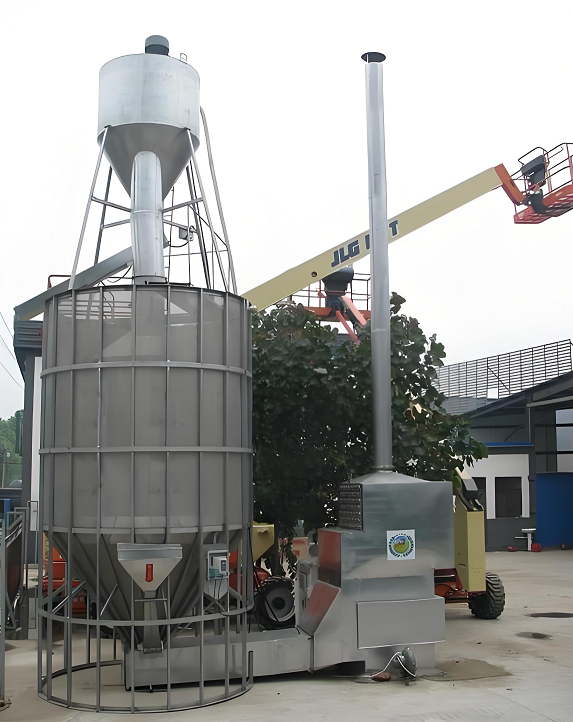Recently, the intelligent zero-damage air suction circulation grain dryer developed by the Institute of Agricultural Product Processing of the Chinese Academy of Agricultural Sciences was put into use.
The core of this technology is to let the grain rise with the hot air during the grain drying process, avoiding mechanical impact, reducing the grain drying damage rate to less than 0.1%, achieving zero damage in the grain drying process, and reducing energy consumption by more than 40%.
At present, although my country’s grain drying technology has made great progress, core technologies with independent intellectual property rights are still very scarce. Therefore, we are determined to overcome the core technology of grain drying. There are three major bottlenecks in traditional drying technology and equipment, namely, high grain damage rate, low drying rate, and low grain quality after drying. The biggest challenge is how to break away from traditional dryer technology and mechanical structure and create a new mechanical principle and mechanical structure. In addition to the motor, the rest of the dryer’s equipment, systems, core components, and parts need to be independently developed, designed, molded, trial-produced, tested, and manufactured.
Improving drying efficiency is another difficult problem to overcome. The key to improving drying efficiency is to use hot air throughout the drying process. The newly developed dryer uses air suction technology. Compared with the technology used in traditional dryers, this technology doubles the contact range between hot air and grain, thereby improving the efficiency of hot air use. Traditional technology uses primary drying, while air suction technology uses secondary drying. The grain lifting process is divided into two processes: primary drying during the lifting process and secondary drying in the warehouse.
To this end, the team created a full coverage technology of the inner and outer cylinder structure. The inner cylinder and the outer cylinder are set up. The inner cylinder serves as a hot air chamber, allowing the lifted hot air to enter; between the inner and outer cylinders is a drying chamber, which allows the hot air to pass through the grain layer from the inside to the outside for heat exchange and then be discharged outside the machine, realizing the efficient use of hot air cascade.
Through innovative design, the team has improved the efficiency of hot air use and drying efficiency and reduced energy consumption. The air suction circulation dryer has a natural wind drying function. When the natural environment temperature is higher than 30 degrees Celsius and the humidity is lower than 40%, all kinds of grain and oil crops can be naturally dried. Compared with traditional dryers, energy consumption is reduced by more than 40%.
This series of dryers also adopts modular design and is equipped with intelligent control and monitoring systems, which realizes intelligent control of drying operations, real-time monitoring of temperature and moisture, and improves drying accuracy and efficiency.
“Our team also cooperated with the Nanjing Agricultural Mechanization Research Institute of the Ministry of Agriculture and Rural Affairs to reveal the drying characteristics of bulk grains, draw drying dynamics curves, and construct a heat and moisture transfer model based on the dryer.
Applicable to a variety of cash crops
With the acceleration of my country’s urbanization process, the promotion of land transfer policies, and the gradual formation of large-scale land management, the market demand for grain dryers continues to increase. New business entities that plant more than 500 acres of grain crops must be equipped with grain dryers to ensure the safety of grain production and the return of grains to the warehouse.
Nowadays, the intelligent zero-damage air suction circulation grain dryer can not only handle the three major staple foods such as corn, wheat, and rice, but also dry a variety of cash crops, such as peanuts, peanut fruit, oil tea fruit, rapeseed, soybeans, and cyperus rotundus.
In order to solve the key problem of the applicability of drying seeds for a variety of crops, we have innovatively developed an automatic plate feeding control system. The system has set up a material operation platform and installed a plate in the platform. The plate can transport various materials to the expanded feeding port to achieve multiple uses of one machine. Specifically, I We use intelligent control to adjust the air volume and wind speed to achieve drying of various materials, and add electronic frequency modulation. In this way, regardless of the size and weight of the particles, lifting, circulation and drying can be achieved.
The quality of wheat dried by the intelligent zero-damage air suction circulation grain dryer is better than that of natural drying; the polished rice rate of dried rice is 2-3 percentage points higher than that of natural drying. If the corn is not damaged after drying, it will reduce the loss and increase the income by 3% compared with the use of a drying tower, and the value-added per ton will be 72 yuan; the bulk density of corn will increase by one level after drying, and the income can be increased by 40 yuan per ton; after drying, the corn is clean, bright, hairless and free of small impurities, and the income can be increased by 2 cents per catty, and the income can be increased by 40 yuan per ton. The use of this technology can also significantly reduce the content of mycotoxins in grains, and the comprehensive income can be increased by about 150 yuan per ton.
The application of this technology can reduce the grain damage rate by about 2%, which is equivalent to an increase of 2%, which is of great significance for ensuring national food security. In addition, this technology can reduce the amount of bacteria in grains, reduce the level of mycotoxin pollution, and improve the quality of grains, which is also of great significance for ensuring national food safety and people’s life and health.
Post time: Mar-26-2025


